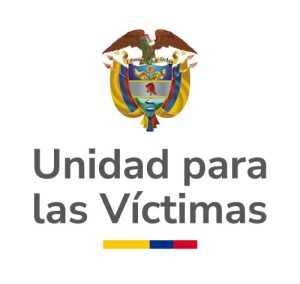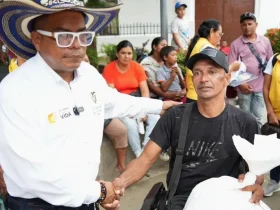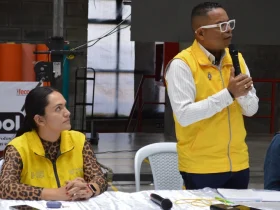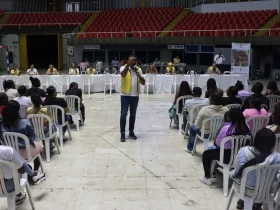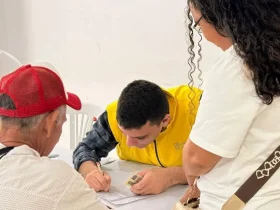The moments before the tragedy, in May 1994 near Cartagena del Chaira (Caqueta), are vivid in his memory: “We were playing soccer in an empty field. I went out for a moment to drink water nearby, later I needed to take a piss and I went to a hill far from the road; the explosion happened there. I had a few lucid moments. I thought about my family and that’s as far as I can remember.”
With the loss of his left leg, Alonso became one of the nearly 12,100 antipersonnel mines, unexploded ordnance, and improvised explosive devices victims in Colombia.
He is 57 years old, born in Solita (Caqueta) and is the youngest of six siblings. His childhood was spent in the countryside where he had great skill. Since he was a child, his parents taught him how to work the soil, particularly in banana, corn, and rice crops.
He remembers he had few friends because he was shy and attached to his mother. Like many children and young people in the countryside, he only managed to study up to the seventh grade, however, a short time ago and when he was almost 50 years old, he finished high school.
When he was 15, he and his family went to Florencia because the economic situation was a bit tight. His father had died and that worsened the situation.
In Florencia, his mother Eloisa Huaca worked washing clothes and housekeeping family homes. “We lived by with that because my father had already passed away and my mother was in charge of us. She was the one who brought us forward in my father’s absence.”
Alonso began working in a tile factory where he earned well. After several years and already with a girlfriend, an acquaintance asked him to work in a farm, so he decided to return to the kind of work he knew since he was little. Around those days, many rural areas in the country’s south had peasants working in coca leaves fields. “I went there to work as a “raspachin” (coca leave picker), as well as in other legal crops in Las Ilusiones village in Cartagena del Chaira. About once a month I would go to Florencia to visit my mother and my wife and give them money.”
The horrific day
Alonso and his friends enjoyed playing soccer on a makeshift field they made in a clear area where trees had been removed.
On May 25th, 1994, around 10:30 in the morning, thirsty, he withdrew a few meters from the field to a kind of slope, when Alonso heard an explosion that blew him away. Before losing consciousness, he realized his left leg was gone. For a moment, his mother, his wife, and his children were in his mind. He thought he was going to die.
This is something he doesn’t like to talk about. For a few years, on several occasions he thought about ending his life: “I used to think I was useless the way I was. I was also self-conscious when people saw me without a leg, and I tried to hide my hand by wearing long-sleeved shirts because it had also been affected by the explosion.”
But he understood it was not about giving up, but rather, about overcoming adversity. Initially, he decided to walk without prosthesis using a crutch, something he perfected over time.
A couple of years later he had his first prosthetic device, and it was very difficult to adapt to it, mainly because of the pain, but in short, the deal was hard. First, he had the prosthetic and two crutches, then the prosthetic and two canes, and finally, the prosthetic and a cane. Subsequently, his Health Care gave him the prosthetic device he currently uses. “At first it was difficult to get used to it. Sometimes, it would loosen when I was walking down the street and it would come out. I felt embarrassed cause I had to drop my pants and fix it. Later I managed to adapt with habit and some tricks; today I handle it well”
Alonso’s workshops
En 2009, por la necesidad que tenía un grupo de personas que se unieron para reclamar sus derechos, Alonso creó la Asociación de Sobrevivientes de Minas Antipersonal, Munición sin Explosionar y Trampas Explosivas del Caquetá “Unidos por la vida” que desde el 2011 ha participado en procesos de recuperación física y emocional.
In 2009, a group of people came together to claim their rights, and due to this, Alonso created the Caqueta’s Antipersonnel Mines, Unexploded Ammunition and Explosive Traps Survivors Association “Unidos por la Vida”, which has participated in physical and emotional recovery processes since 2011.
Currently, “Unidos por la Vida” is made up of 85 people, but they estimate they’ll have around 105 people by the end of 2022.
Since 2018, the organization has host workshops in rural communities aimed at preventing antipersonnel mines accidents. Alonso, who is one of the instructors, says they have trained nearly 6,000 people from rural areas of Caqueta’s 16 municipalities to date. For such activities, they have had the Comprehensive Action Against Antipersonnel Mines (AICMA) support, an entity attached to the Peace Humanity & Inclusion High Commissioner’s Office, which is an independent and impartial international aid organization that works alongside people with disabilities and vulnerable populations, to respond to their essential needs, improve their living conditions and promote respect for their dignity and fundamental rights.
“We have been mines victims, so the community opens its doors to us more easily. In the red zones there’s always mistrust when it comes to strangers. The other thing that makes it easier for us to reach communities is our civilian status. Among our organization’s principles you find humanity, neutrality, and impartiality,” adds Alonso.
Según cifras de AICMA, entre enero de 1990 y enero de 2022 en Caquetá se han presentado 602 accidentes con minas antipersonal o municiones sin explotar o artefactos explosivos improvisados donde sobresale San Vicente del Caguán con 178 casos mientras que Albania tiene cero casos.
According to AICMA figures, between January 1990 and January 2022 there have been 602 accidents with antipersonnel mines, unexploded ordnance or improvised explosive devices in Caqueta, where San Vicente del Caguan stands out with 178 cases while Albania has zero.
In the Unit for the Victims’ Single Victims Registry (RUV), from 2012 to February 2022, 6,347 people are included due to accidents with antipersonnel mines, unexploded ordnance, and improvised explosive devices (MAP, UXO and AEI, respectively), of which 5,816 are subject to care, which means they meet legal requirements to access integral reparation.
In 2013, Alonso received compensation from the Unit for the Victims, and he used it to set up an Xbox sales business. It didn’t work out as expected for lack of commercial training, but he highlights the entity’s role regarding psychosocial support and collective reparation.
Later he applied and was elected to the Florencia Municipal Victims Board, where he has already served two terms. He thinks this work has been an interesting experience, but he believes there’s still not enough links between different local entities and the victims’ representatives.
If one day Alonso meets the person who laid the mine that crippled him, he will tell him to stop doing evil, he will invite him to reconcile and make a new life looking towards the future. “I have no grudge against anyone. I live day by day happily and I thank God for saving my life almost 28 years ago.”
Today he looks to the future with optimism, he wants to increase the associates’ number in his organization and reach more communities with his prevention workshops. An antipersonnel mine got in his life’s way, but Alonso has the strength to achieve what he wants and bare results with the new chance he got.
(End/CMS/COG/RAM)

